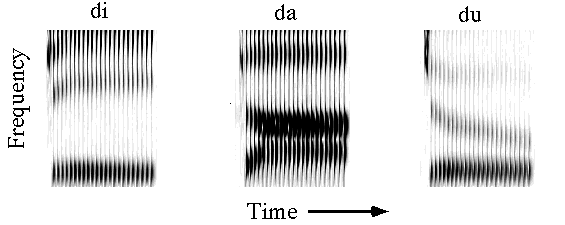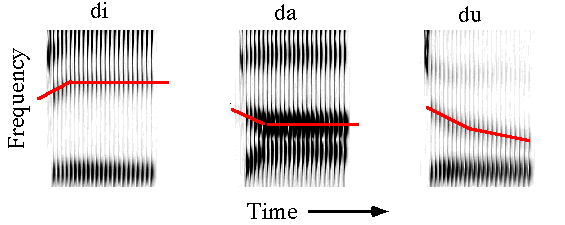
The direction and extent of formant transitions that give rise to the percept of the same consonant differ as a function of the vowel context in which the consonant occurs.
There is, therefore, no simple one-to-one relation between the sound (formant transitions) and the perceived consonant.
Here are some formant patterns that give rise to the percept of a tongue-tip stop consonant [d] in the context of different vowels.

 click on the above
display to hear the three syllables.
click on the above
display to hear the three syllables.Note that the direction of formant transitions that result in a [d] percept differ between the [i] context (rising) and the [a] and [u] contexts (falling).
In isolation, formant transitions moving in opposite directions sound like quite different auditory events. They have been dubbed "chirps."
|
|
|
Nonetheless, in the appropriate speech contexts, these transitions do not sound like chirps and give rise to the percept of the same consonant.
Two questions arise here:
- why does the speech signal have this property?
- how does the speech perception system deal with apparent complexity?
The phonemic representation of speech as a sequence of symbols led scientists to expect that it would be possible to chop the acoustic signal up into chunks such that each chunk correponded to one of the phonemes.
In fact, in this turns out not to be possible. No matter where you segment a stop-vowel syllable, the first segment will either sound like a consonant-vowel syllable, or not like speech at all.There is no place where you can cut the syllable to hear only the consonant.
Here are tokens of synthetic di da du that have been cut so as to retain only their first 25 milliseconds:
Why does speech have this property?
In general, listeners' ability to discriminate sounds is much better than their ability to categorize them. That is, people can usually distinguish small differences among the exemplars of a category.
Early research on speech perception suggested that people's ability to discriminate speech signals along a continuum was no better than their ability to categorize them in terms of place or voicing.
Theoretical results exhibiting categorical perception:
Experiment on /bdg/ (after Liberman, 1970):
Stimuli:
Results:
Later research has shown that such categorical effects are not exclusively to speech. Nonetheless, the fact that categorical perception is (approximately) true of speech needs to be explained.